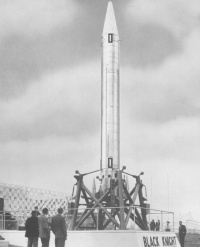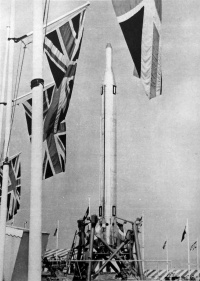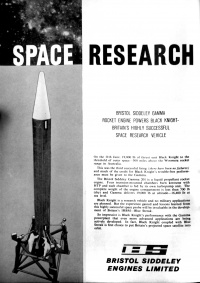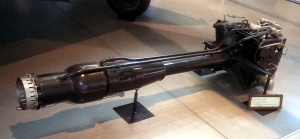Black Knight
From The Space Library
Saunders Roe Black Knight Missile (circa 1958)
Black Knight with second stage (circa 1959)
Black Knight advert 1959
The Black Knight missile program began in 1954 as a project of the Royal Aircraft Establishment (RAE) and the Saunders Roe Company of England. Black Knight was intended as a test vehicle for lobbing dummy nuclear warheads into space to monitor their behaviour during re-entry. The contract was issued on July 29 1955 for Saunders Roe to build the vehicle while Armstrong Siddeley Motors Ltd would develop the propulsion system.
On November 5th 1956 De Havilland bought an interest in Saunders Roe and when the first Black Knight was fired from Woomera Australia on September 7th 1958, the launch team was supervised by H.G.R. Robinson of RAE and K.M. Burtt of De Havilland Propellers Ltd, who was the team leader. This was also in part so that the De Havilland engineers could get experience with large rockets before completing the Blue Streak LRBM.
De Havilland had been working with rocket engines since the late 1940s in conjunction with the newly formed Rocket Propulsion Establishment. The RPE had recruited a team of Germans after the war led by Johannes Schmidt. Schmidt had worked on the Walter HWK 109-509 used on the Me-163 interceptor and the Walter ATO.
Walter HWK 109-509 liquid rocket engine, Udvar Hazy Center, Washington DC
Two of these Walter engines, which used high test peroxide (HTP) as an oxidizer and hydrazine hydrate and methanol as fuel, were brought to England and fitted to an Avro Lancastrian (one of the aircraft which James C. Floyd had worked on) to see how they would perform as JATOs. The success of that experiment led to De Havilland going ahead in 1951 with their own HTP engine project. The first engine was the Sprite ATO followed by the Super-Sprite unit for the Vickers-Valiant aircraft. Both built while Arthur Valentine Cleaver of the British Interplanetary Society was chief rocket engineer at the De Havilland Engine Company.
This led to the Spectre JATO rocket, which was first tested in December 1956. After the early tests aboard an English Electric Canberra the engine was fitted to a Saunders Roe S-R 53 interceptor research aircraft. The first flight of this configuration was in May 1957.
Ultimately the work done at Saunders Roe, RAE and De Havilland on rockets using HTP led to the extremely reliable "Gamma" engines used on the Black Knight.
The guidance system for Black Knight was developed by Dr Karl Schirrmacher, another German rocket scientist who had worked on the Wasserfall and Rheintochter missiles during the war.
Black Knight would be launched successfully 22 times using HTP and kerosene. For fourteen of those flights it used a Gamma 201 engine with four thrust chambers each generating about 4,000 lbs. Total thrust rose to about 18,000 lbs outside the atmosphere. The Black Knight was normally about 32 ft 10 in tall and 3 ft in diameter. Fully fueled it weighed 13072 lbs in its single stage version. The remaining eight flights used the uprated Gamma 301 engines.
A two-stage version of Black Knight incorporated a Cuckoo II solid motor which was rotated 180 degrees from the direction of flight. This was attached to a dummy nuclear warhead which after staging would fire and propel the dummy into the atmosphere at reentry speeds. Analysis of some Cuckoo II failures were undertaken by Walter Riedel. The Cuckoo II was an offshoot of the Raven solid fuel rocket developed for the Skylark sounding rocket by RPE.
In about 1960 the De Havilland engineer Geoffrey Pardoe proposed a modified version of Black Knight as a second stage for the De Havilland Blue Streak LRBM. This combination would have allowed Britain to enter the space race with its own satellite launcher. Although this configuration never flew, the engines from Black Knight would evolve to power the Black Arrow launcher which put England's satellite Prospero into orbit in 1971.




